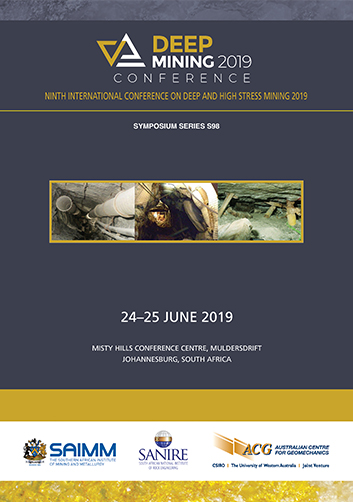Advanced techniques for the monitoring of pillar and excavation behaviour at a deep level massive mine

|
Authors: Andrews, PG; Rwodzi, L; Ekkerd, J; Ratshitaka, N |
DOI https://doi.org/10.36487/ACG_rep/1952_11_Andrews
Cite As:
Andrews, PG, Rwodzi, L, Ekkerd, J & Ratshitaka, N 2019, 'Advanced techniques for the monitoring of pillar and excavation behaviour at a deep level massive mine', in W Joughin (ed.), Deep Mining 2019: Proceedings of the Ninth International Conference on Deep and High Stress Mining, The Southern African Institute of Mining and Metallurgy, Johannesburg, pp. 133-148, https://doi.org/10.36487/ACG_rep/1952_11_Andrews
Abstract:
The mining methods used at South Deep started with conventional mining (pre-1998), which later evolved into mechanized mining with various layouts for drifting and benching, low-profile horizontal destressing with crush pillars and long hole stoping (LHS). The mining method was then changed during 2015-2016 to the current high profile destress with LHS. Pillars in the destress cuts are designed to yield and not pose a significant rock burst risk. High profile development was initially conducted using smaller pillars (4.5 m x 10 m and 6 m x 10 m) which completely yielded however, as these were prone to excessive scaling and extensive rehabilitation requirements. Numerical modelling was conducted by Lilly, (2016), to optimise the destress pillar dimensions. The study concluded that a larger yield pillar is viable in the high profile destress cuts. The new pillar design was still not proven in situ owing to lack of information regarding to yielding, closure rates, convergence and fracturing through the core as well as the transition between the old and new mining layout. As a first approach, borehole camera surveys were conducted to assess the pillar conditions. Ground penetrating radar (GPR) technology was then used to determine fracturing around the yield pillars and where possible, the results where compared to the borehole camera surveys. A Zeb Revo scanner was then used to obtain accurate closure and pillar yield performance. This data was used to calibrate actual vs model-predicted displacements and to calibrate numerical models, reconciling pillar and also pro-actively identify areas that were undergoing extensive deformation. This paper will describe the outcome of the above-mentioned monitoring and reconciliation programmes and the interpretation of the results.
References:
Andrews, P. (2017). The Highs and Lows of Gold Fields Monitoring Experiences. Developments in Rock Stress Measurements and Monitoring Seminar.
Hedley, D.G.F., and Grant, F. (1972). "Stope and pillar design for the Elliot lake uranium mines," Can. Inst. Min. Metall. Bull, Vol. 65, pp. 37-44.
Hoek, E. and Brown, E.T. (1980). Underground Excavations in Rock, Inst. Min. Metall., London.
Jager, A.J and Ryder J.A. (1999). A Handbook on Rock Engineering Practice for Tabular Hard Rock Mines. The Safety in Mines Research Advisory Committee (SIMRAC) Publications.
Jones, E. and Beck, D. (2017). The use of three-dimensional laser scanning for deformation monitoring in underground mines. Proceedings of the 13th AusIMM Underground Operators Conference: Paper No. 066 pp. 267–270.
Joughin et al (2011). Mining methods and backfill at South Deep Gold Mine. W.C. JOUGHIN*, W.M. BESTER† and M. DU PLOOY† *SRK Consulting, South Africa. South Deep Gold Mine, South Africa.
Kaiser, P.K. McCreath, D.R and Tannant, D.D. (1996). The Canadian Rockburst. Canada
Kaiser, P.K. et al (2018). The Canadian Rockburst. Canada
Krauland, N. and Soder, P.E. (1987). "Determining pillar strength from pillar failure observations," Eng. Min. Journal, Vol. 8, pp. 34-40.
Lilley, C. (2014). “Assessment of Stoping Methods for South Deep”. Internal report by Beck Engineering.
Lilley, C. (2016). “Assessment of alternative yield pillar layouts for South Deep”. Internal report by Beck Engineering.
Lunder, P.J. (1994) "Hard Rock Pillar Strength Estimation an Applied Approach," MASc. Thesis, Dept. Mining and Mineral Process Engineering, University of British Columbia.
Lunder, P.J. and Pakalnis, R. (1997). "Determining the strength of hard rock mine pillars," Bull. Can. Inst. Min. Metall., Vol. 90, pp. 51-55.
Martin, C.D. and Maybee, W.G. (2000). "The strength of hard rock pillars," Int. Jnl. Rock Mechanics and Min. Sci., Vol. 37, pp. 1239-1246.
Ozbay, M.U., Ryder, J.A and Jager, A.J. (1995). The design of pillar systems as practised in shallow hard-rock tabular mines in South Africa. The Journal of The South African Institute of Mining and Metallurgy, vol. 84, no. 8, pp. 7 – 18.
Potvin, Y, Hudyma, M., and Miller, H.D.S. (1989). "Rib pillar design in open stoping," Can. Inst. Min. Metall. Bull. Vol. 82, pp. 31-36.
Potvin, Y. (2018) Personal Communication.
Ryder, J.A and Jager, A.J. (2002). A text book on Rock Mechanics for tabular hard rock mines. Johannesburg, South Africa: The Safety in Mines Research Advisory Committee (SIMRAC); in conjunction with CSIR Division of Mining Technology.
Sjoberg, J. (1992a). Failure modes and pillar behaviour in the Zinkgruvan mine. Rock Mechanics. Lulea University, Department of Mining Engineering. Rotterdam: Balkemia.
Sjoberg, J. (1992b). Stability and Design of Stope Roofs and Sill Pillars in Cut and Fill and Open Stope Mining with Application to Zinkgruvan Mines. Licentiate Thesis, Lulea University of Technology, Lulea, Sweden.
Von Kimmelman, M.R., Hyde, B. and Madgwick, R.J. (1984). "The use of computer applications at BCL Limited in planning pillar extraction and the design of mining layouts," In Design and Performance of Underground Excavations, Int. Soc. Rock Mech. Symposium, Brown and Hudson, eds., Brit. Geotech. Soc., London, pp. 53-63.
Y. Dong, F. Ansari, in Service Life Estimation and Extension of Civil Engineering Structures (2011).
© Copyright 2025, Australian Centre for Geomechanics (ACG), The University of Western Australia. All rights reserved.
View copyright/legal information
Please direct any queries or error reports to repository-acg@uwa.edu.au
View copyright/legal information
Please direct any queries or error reports to repository-acg@uwa.edu.au